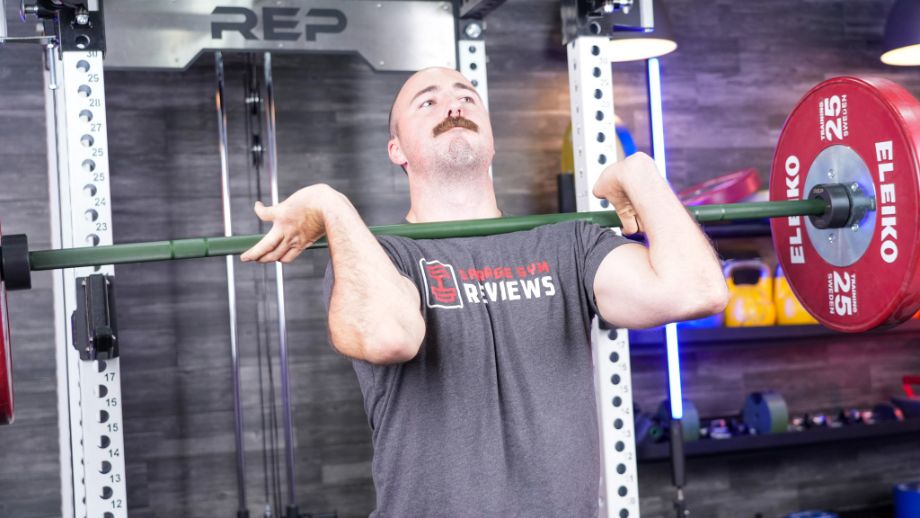We test and review fitness products based on an independent, multi-point methodology. If you use our links to purchase something, we may earn a commission. Read our disclosures.
We once left the Olympic lifts to the Olympians, but thanks to CrossFit, a significantly wider audience has begun incorporating these advanced weightlifting maneuvers into their strength training. We here at GGR are all in favor of that; Olympic lifts build some big-time explosive power, helping strength athletes and weekend warriors worldwide accomplish their fitness goals and reach their full potential.
The only problem—let’s be honest—is they’re really hard! You need your body to execute with precision to fling a heavy barbell from the floor to the overhead position. It’s a movement that embodies power and grace when performed with proper form, but it takes a lot of practice to get it right.
RELATED: An Olympian’s Guide to Equipment for Olympic Weightlifting
That’s why we have Caine Wilkes, OLY, USAW-L1, and GGR senior staff writer, sharing one of his favorite modified Olympic lifts that’ll help you get the hang of this super technical maneuver: the hang clean.
We’ve got step-by-step instructions, variations, alternatives, benefits, and more!
How To Do the Hang Clean
The full clean involves lifting a barbell from the floor and into the front rack position using a powerful hip drive. The hang clean makes things more manageable by cutting that range of motion down and starting from the hang position, roughly right above your knees, instead.
You’ll still need a strong hip drive and a well-timed “catch,” but you’ll expend considerably less effort on the hang clean versus the full clean, allowing you to really hone in on your form.
How to do it:
- Stand with your feet hip-width apart and an Olympic barbell held in the hang position using a double-overhand or hook grip that’s slightly outside of shoulder-width.
- Hinge forward from your hips and slightly bend your knees.
- Drive through your heels, explosively extend your ankles, knees, and hips, and pull the bar toward your chin simultaneously.
- As the bar rises to roughly chest height, shrug your shoulders, push your elbows forward and under the bar, and bend your knees to catch the bar in a squat position.
- Stabilize the bar from the bottom of your squat, then return to a standing position.
- Slowly guide the bar back down to the hang position.
- Reset and repeat for reps.
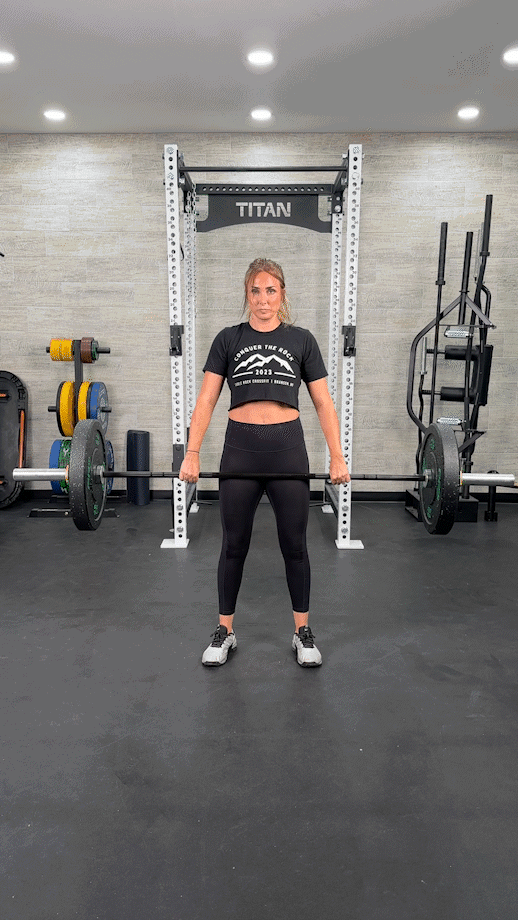
Modifications
- Dial it back: Performing hang cleans with a training bar or length of PVC pipe lets you focus on getting the form right without having to manage heavy weights. You may also consider the hang clean high pull, which involves doing the hip drive without the catch.
- Make it harder: Once your hang clean looks pristine, it’s time to graduate to the full squat clean and lifting from the floor. Adding more weight always works, too!
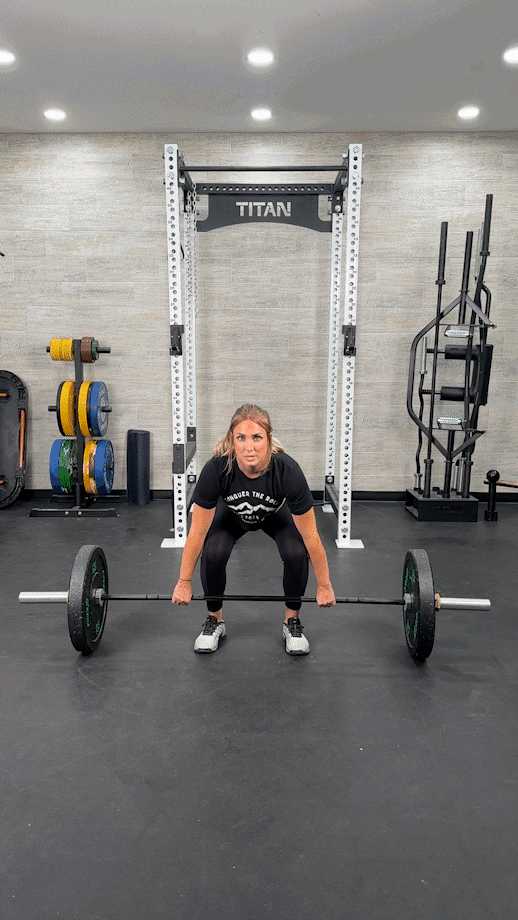
How To Do a Hang Clean At Home
We love MacGyvering some makeshift fitness equipment stand-ins for the budget-conscious, but you really need a high-quality Olympic barbell to perform real bona fide hang cleans. You can, however, use a pair of the best dumbbells or kettlebells to perform the hang clean exercise if your budget or floor plan can’t accommodate a beefy barbell.
Hang Clean Variations
- Hang power clean: The hang power clean takes the squat out of the standard hang clean, so, instead of catching in a squat position, you catch the bar standing upright.
- Hang clean high pull: The hang clean high pull makes the movement even more manageable by requiring the hip drive and pulling portion only. The lifter can focus on building strength and technique without having to figure out the catch portion just yet.
- Dumbbell hang clean: Using dumbbells for the hang clean exercise lets you reap many of the same rewards without having to develop as much technique.
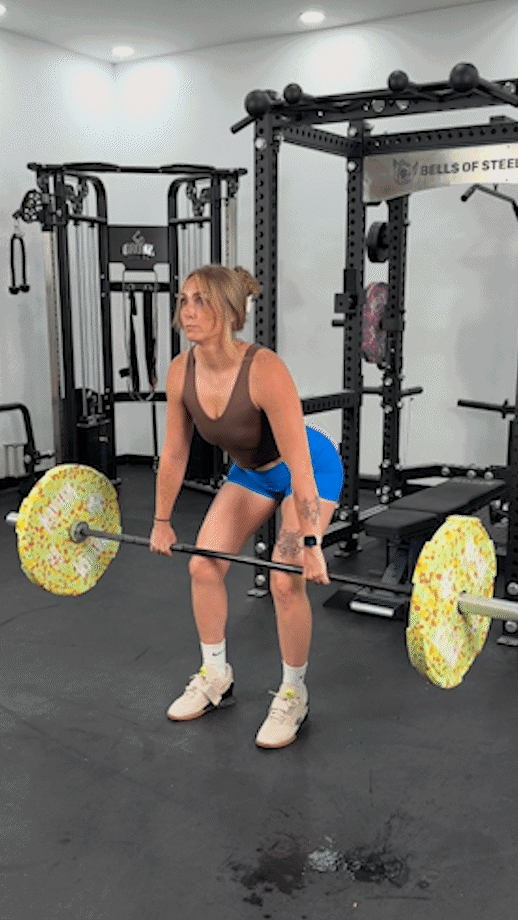
Hang Clean Alternatives
The hang clean is an incredibly useful way for Olympic weightlifting beginners to wrap their minds and bodies around the form and a full-body exercise to help you progress your other fitness goals.
For the best results, it’s prudent to pencil in a few hang clean alternatives into your workout routine.
Front Squat
Why do it: “The hang clean involves catching the barbell in the front-rack position in a full squat,” says Caine Wilkes, OLY, USAW-L1. “So, the front squat is a way to build strength and mobility in the same muscle groups without having to learn as much technique.”
How to do it:
- Adjust the J-hooks of your squat or power rack so the bar is at shoulder height.
- Load your barbell and step underneath it with your feet hip-width apart.
- Unrack the barbell onto your upper chest, holding it with your palms facing up.
- Step away from the rack, brace your core, and squeeze your glutes.
- Push your hips back and bend your knees to squat.
- Continue until your thighs are parallel with the floor.
- Pause, then drive through your heels to return to the starting position.
- Repeat for reps.
RELATED: Front Squat Vs Back Squat
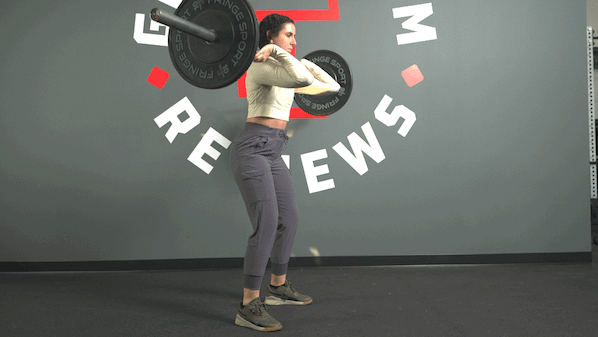
Deadlifts
Why do it: The deadlift is ostensibly the greatest lift of all time, but how does it help with your hang clean? Both exercises involve using a powerful hip extension and your posterior chain muscles to move the barbell, so becoming more proficient with your deadlifts may translate to an easier time on hang cleans and other Olympic lifts.
How to do it:
- Stand over a loaded barbell with your feet shoulder-width apart.
- Bend your knees and push your hips back to grip the barbell.
- Drive through your heels and extend your knees and hips to stand.
- Squeeze your glutes at the top, then slowly return the bar to the floor.
- Repeat for reps.
RELATED: 13 Deadlift Benefits
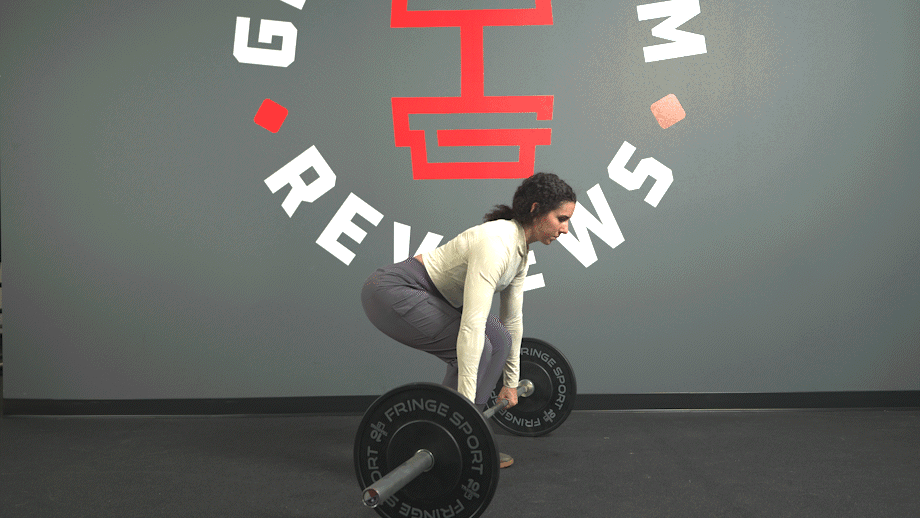
Kettlebell Swings
Why do it: According to the Journal of Strength and Conditioning Research1, “Kettlebells may be an effective alternative tool to improve performance in weightlifting and powerlifting,” as a 2013 study found that participants who performed kettlebell training improved their bench press and clean and jerk performance after a 10-week period.
How to do it:
- Stand with your feet shoulder-width apart holding a kettlebell with both hands.
- Hinge forward by pushing your hips back, lowering your chest, and bending your knees. Keep your back straight, core tight, and your arms fully extended as you hinge.
- Pop your hips, hinging back into an upright position, to thrust the kettlebell upward. Guide the kettlebell to chest height for Russian KBS or overhead for American KBS.
- Pause at the top, then allow the kettlebell to swing back down past the starting position and through your legs. Hinge forward again to accommodate the kettlebell’s momentum.
- Once the kettlebell starts swinging forward again, pop your hips to cycle into the next rep.
- Repeat for reps.
RELATED: Kettlebell Swings
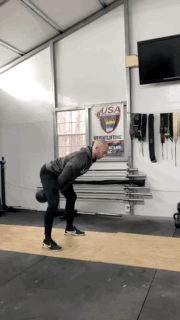
Clean and Jerk
Why do it: “The clean and jerk takes your hang clean to the next level and then some,” says Caine. “It features a greater range of motion and adds a jerk exercise at the end, so you’ll build muscle in even more muscle groups while fine-tuning the movement mechanics and increasing your overhead lockout strength, too.”
How to do it:
- Stand with your feet hip-width apart and a loaded barbell on the floor in front of you.
- Hinge forward, reach down, and grip the barbell using a double-overhand or hook grip.
- Initiate the first pull by driving through your heels and extending your knees and hips as you would during a deadlift. Keep the barbell close to your body as you rise.
- Initiate your second pull as the barbell passes your knees by driving your hips forward.
- As the bar rises to chest height, rotate your elbows beneath the barbell and drop into a squat to catch the barbell in the front-rack position.
- Pause at the bottom of the squat, then drive through your heels to stand.
- Bend your knees slightly, bringing your hips back, then extend them both quickly to propel the bar overhead.
- Drop into a partial squat and stabilize the bar.
- Return to a standing position to finish the rep.
- Return the barbell to the floor, reset, then repeat for reps.
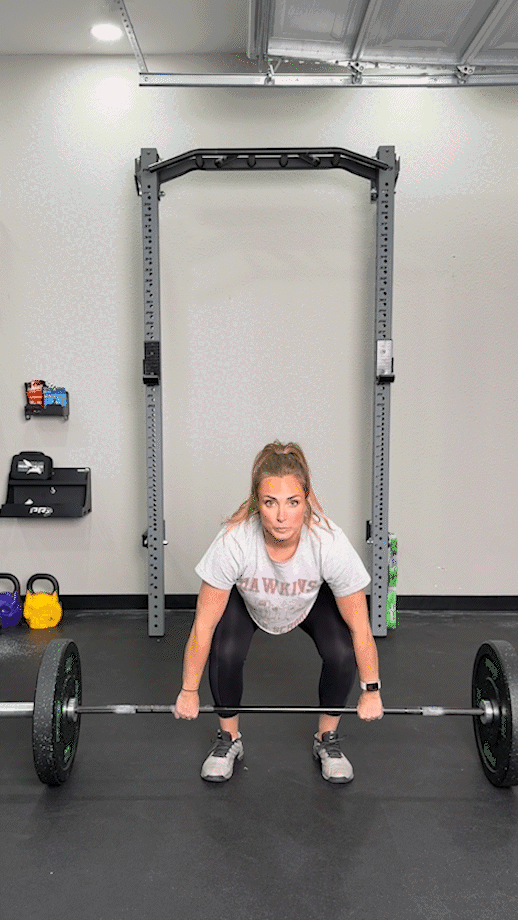
Block Clean
Why do it: Are you still struggling to do cleans with perfect form? You can clean that up by working block cleans into your routine. Block cleans allow the lifter to perform the exercise from a higher position (or a deficit). Because of this, you can isolate problem areas and practice without having to do reps from the floor every time.
How to do it:
- Set your blocks up to reach the desired starting height.
- Place your barbell on the blocks and load it to your desired weight.
- Stand over your barbell, just as you would for a regular clean.
- Hinge forward at your hips, reach down, and grip the barbell.
- Drive through your heels, explosively extend your ankles, knees, and hips, and pull the bar toward your chin to perform your clean exercise.
- Rotate your elbows to catch the bar as you drop into a squat position.
- Stabilize the bar from the bottom of your squat, then return to a standing position.
- Slowly return the bar to the blocks, reset, and repeat for reps.
Benefits of the Hang Clean
The hang clean is more beginner-friendly than the full clean, but it’s still a fairly complex lift. So, what kinds of benefits should you expect to get from your hard work?
Provides Full-Body Muscle Activation
The untrained eye may mistake the hang clean for an arm exercise, but seasoned lifters know firsthand that there’s much more going on when you’re performing this movement.
“The hang clean involves a triple extension of the ankles, knees, and hips, making it as much a lower-body exercise as it is an upper-body exercise, if not more so,” says Caine Wilkes, OLY, USAW-L1.
According to the Journal of Sports Science & Medicine2, the hang clean activates numerous muscles and muscle groups, including your quads, glutes, hamstrings, core muscles, erector spinae of your lower back, and the trapezius in your upper back.
So, as a full-body exercise, you can make some major strength and hypertrophy gains with this level of muscle activation. When properly programmed, it makes a welcome addition to any strength, powerlifting, or bodybuilding workout program.
Helps Enhance Your Athletic Abilities
Practicing and perfecting the mechanics of this advanced weightlifting maneuver doesn’t only mean you’re a better Olympic weightlifter; your athletic abilities, in general, may improve as well.
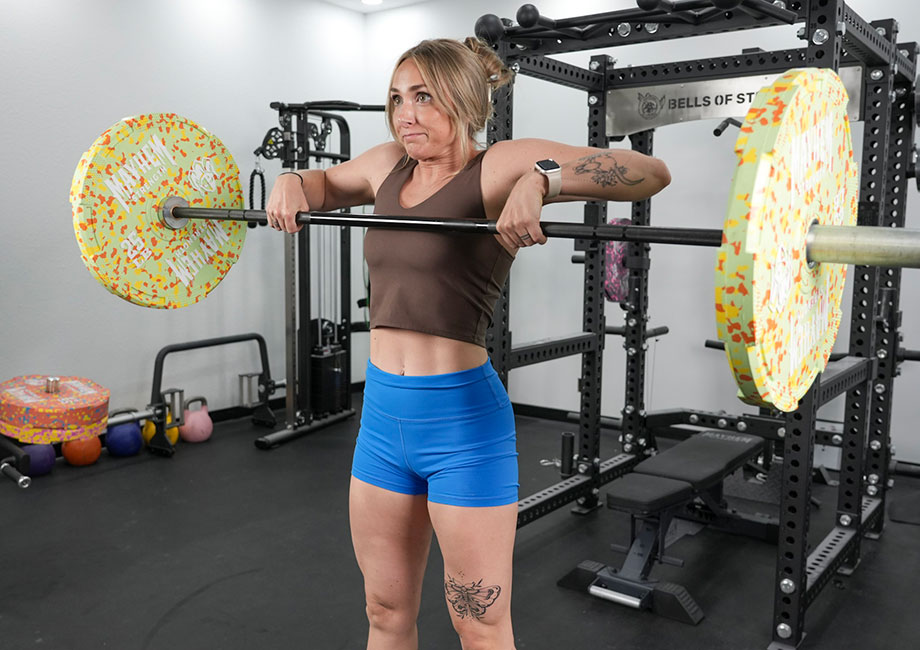
A 2008 study in the Journal of Strength and Conditioning3 observed this, stating there were “Significant correlations between most of, but not all, combinations of performances of hang power clean, jumping, sprinting, [changing of direction], maximum strength, and power.”
That’s not all; a 2016 study in Biology of Sport4 found that hang cleans and hang snatches are “Among the most effective ways to improve power, strength, and speed in athletes.”
Helps Improve Your Olympic Weightlifting Technique
Not all of us are aspiring Olympic weightlifters in the making. But for those of us who are always up for taking on a new fitness challenge, mastering the hang clean means you’re well on your way to more advanced lifts, including the squat clean, clean and jerk, and snatch exercise.
“Taking your time to develop the technique to properly execute the hang clean builds the muscle you need to perform the more advanced versions of the exercise, but it’s more than that,” Caine says. “You’re also building coordination, technique, and confidence that, when you have a heavy barbell in front of you, you know you got this!”
Common Hang Clean Mistakes
The perfect hang clean takes only a few short seconds to execute, but that doesn’t mean that there aren’t a lot—and we mean A LOT—of things that could go wrong. Here are some common mistakes to avoid as you learn the proper form for this modified Olympic lift.
Relying Too Much on Your Arms
Beginners may see the hang clean performed and (falsely) believe that the arms play a significant role. You’ll need to rely on your grip strength to hold the bar and your arms to guide it, but the power comes from your explosive hip extension.
“You won’t be able to clean nearly as much weight if you’re relying on the arms to muscle the bar into the front-rack position,” says Caine. “It’ll also be difficult to perform the catch if you’re not generating enough power with your initial pull.”
you’ll want to focus your attention and energy on a strong hip drive to avoid this common mistake. Take that extra moment after hinging forward to get your mind right, take a deep breath, and commit hard! It may take several tries, but you can do it!
Swinging the Bar Away From Your Body
The best way to optimize your power output when performing hang cleans is by keeping that bar close to your body and maintaining a straight bar path. Many beginners, however, wind up with a curved bar path because they’re exaggerating the catch.
Swinging the bar away from your body may work at lighter weights, but you’ll have a hard time moving heavier weights if you’re not correcting this mistake. Worse yet, letting the bar get away from you increases your risk of injury because it compromises your neutral alignment and may throw off your balance.
RELATED: Balance Exercises
So, keep that bar nice and tight, generate a strong hip drive to initiate the movement, and get your elbows underneath the bar for the catch while maintaining a bar path that’s nice and straight.
Catching and Squatting in Two Separate Steps
News flash: If you’re catching the barbell in the front-rack position and then squatting with it, you’re not really doing a proper hang clean. You’re doing a hang power clean and a front squat separately.
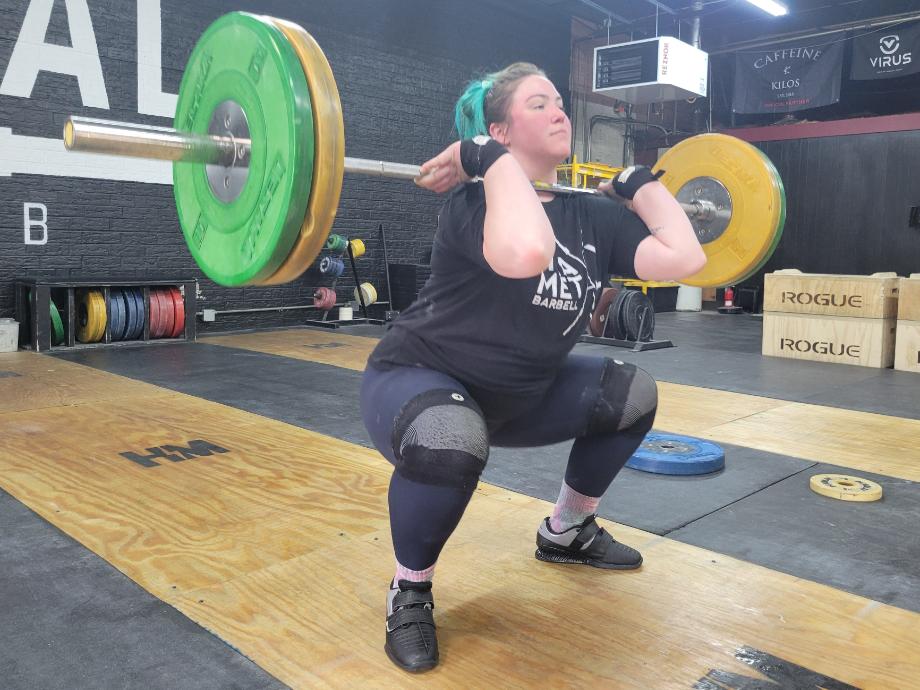
Don’t get us wrong; you’re still engaging numerous muscle groups this way, so you’ll likely walk away with some solid strength and hypertrophy gains regardless. However, the purpose of the hang clean is to improve your power, speed, and technique, and that’s not going to happen as effectively if you’re not getting your body beneath the bar and catching it in a squat position.
“Don’t think of the hang clean as pulling the barbell up into the front-rack position,” says Caine. “Think of it as using your hips to launch the bar into the air and then getting under it for the catch. It’s less about moving the bar to where it should be relative to your body and, instead, moving your body where it should be relative to the bar.”
Muscles Worked by Hang Cleans
The hang clean is categorized as a full-body exercise because it basically wreaks havoc—in a good way!—on your entire posterior chain. The primary movers include:
- Glutes: The hang clean is all about a strong hip extension, so the glutes, the main muscles involved in hip extension, are the most critical muscles utilized.
- Hamstrings: The glutes are the main muscles involved in hip extension, but they get some help from your hammies. Your hamstrings are also integral for knee extension, meaning you’ll be counting on them big time during the first pull of the hang clean.
- Quadriceps: When your knees are flexed, on the other hand, that’s where your quads come in. You’ll mostly activate these bad boys once you catch the barbell in the squat position and move through the final eccentric training phase of the exercise.
- Upper body: A lot of your success will come from your lower body and posterior chain muscles, but your upper body is also working. You’ll need a strong core to hold a rigid posture while the heavy barbell tries pulling you forward. Your traps and lats also come into play during the second pull of the exercise when you’re finally dipping beneath the bar.
Hang Clean: Final Thoughts
Let’s be real—Olympic lifts are hard, but, as they say, sometimes the hardest things in life are the ones most worth doing. The hang clean and other Olympic lifts may not be as simple as other weightlifting exercises, but they offer many benefits nonetheless.
The hang clean:
- Modifies the full clean to make it more beginner-friendly
- Helps build strength, speed, and explosive power
- Provides a full-body workout by activating numerous muscle groups
- Helps enhance athletic ability, coordination, and balance
So, don’t leave those gains hanging! Work the hang clean into your routine today!
Hang Clean: FAQs
What is the proper technique for a hang clean?
The hang clean involves lifting a loaded barbell from the hang position to the front-rack position by driving your hips to create explosive power. When performed correctly, virtually all of the power comes from your lower body, with the upper body assisting only during the catch.
RELATED: Explosive Workouts
What is the difference between a hang clean and a regular clean?
The regular full clean exercise involves lifting the barbell from the floor rather than from the hang position. Mechanically, the movements are otherwise identical.
Are hang cleans safer than deadlifts?
Generally speaking, both exercises are safe, provided you’re lifting with proper form and technique. There’s currently insufficient evidence to determine which exercise is truly safer. That said, there are a few reasons why one may be safer or less safe than the other.
The hang clean involves more explosiveness, which may encourage jerky movements that could lead to injury, but you’re often lifting less weight when doing hang cleans versus deadlifts. Likewise, the deadlift features a smaller range of motion, leaving less room for something to go wrong.
If you’re unsure which exercise may be best for you, consider working with a certified personal trainer, strength coach, or other qualified fitness professional. They’ll not only prescribe the right exercise for your training purposes, but they’ll also make sure you’re doing everything with good form.
RELATED: Best Online Personal Trainers
References
- Manocchia P, Spierer DK, Lufkin AK, Minichiello J, Castro J. Transference of kettlebell training to strength, power, and endurance. J Strength Cond Res. 2013;27(2):477-484. doi:10.1519/JSC.0b013e31825770fe
- Geisler S, Havers T, Isenmann E, et al. Effects of Expertise on Muscle Activity during the Hang Power Clean and Hang Power Snatch Compared to Snatch and Clean Pulls – An Explorative Analysis. J Sports Sci Med. 2023;22(4):778-789. Published 2023 Dec 1. doi:10.52082/jssm.2023.778
- Hori N, Newton RU, Andrews WA, Kawamori N, McGuigan MR, Nosaka K. Does performance of hang power clean differentiate performance of jumping, sprinting, and changing of direction?. J Strength Cond Res. 2008;22(2):412-418. doi:10.1519/JSC.0b013e318166052b
- Ayers JL, DeBeliso M, Sevene TG, Adams KJ. Hang cleans and hang snatches produce similar improvements in female collegiate athletes. Biol Sport. 2016;33(3):251-256. doi:10.5604/20831862.1201814
Further reading

Dive into the cold plunge vs hot tub debate and discover which method offers the best recovery benefits so you can keep your mind and body happy. Read more

Take a gander at out Aukfa Magnetic Elliptical review to decide if you should add this affordable piece of cardio equipment to your home gym. Read more

In this NordicTrack EXP 7i treadmill review, I’ll give you the 4-1-1 on all things related to this well-made cardio machine. Read more

Looking for the best food subscription box for yourself or as a gift for a loved one? With firsthand testing and dietitian input, we recommend 9 top options. Read more

